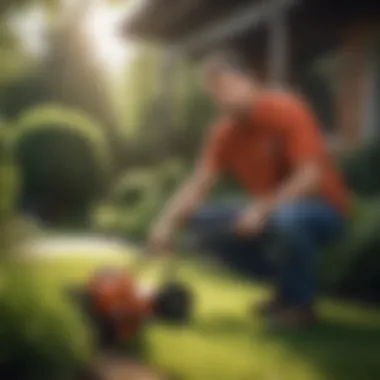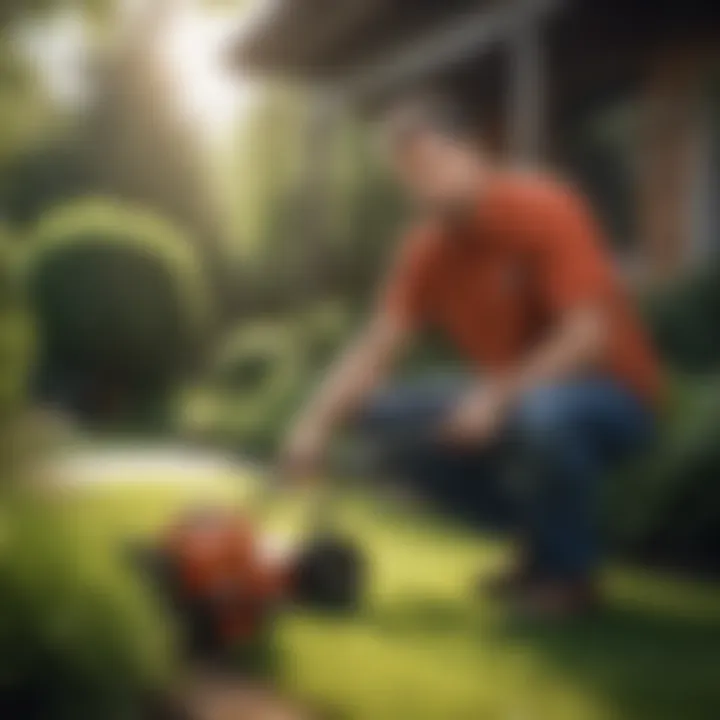The Ultimate Guide to Choosing Your Ideal Yard Trimmer


Intro
Overview of Topic
In the home improvement industry, the selection of a yard trimmer can significantly impact the results of your landscaping efforts. A yard trimmer, or weed eater, serves a vital role in keeping your garden tidy by managing overgrown grass, weeds, and edging along pathways. In a world pursuing aesthetic landscapes, having the right trimming equipment is not simply a convenience; it is essential.
The importance of this topic lies in its practicality. Right equipment not only enhances efficiency but also caters to specific needs, whether that be a small urban garden or a sprawling rural yard. Selecting the correct yard trimmer will facilitate achieving a professional and polished look for your outdoor spaces.
Common Challenges and Solutions
Homeowners will frequently face a variety of challenges with yard trimming. Some common issues include:
- Difficulty in Choosing the Right Trimmer: With many types available, knowing which one fits your needs best can be overwhelming.
- Battery Life Problems: For cordless models, battery life can be limiting.
- Maintenance Issues: Keeping a trimmer in optimal condition ensures safety and performance.
To address these challenges, consider the following solutions:
- Research different types of trimmers.
- Check battery capacity before buying a cordless model.
- Regularly inspect and maintain your equipment for best results.
One crucial element is to read user reviews and instructional guides. Complexities often reveal themselves in everyday use, and consistent maintenance elevates performance over time.
Product Recommendations
When considering which yard trimmer to purchase, products like the DeWalt DCMT570B, Black+Decker LST140C and Ryobi RY254BC stand out in the market.
DeWalt DCMT570B
The key benefits of this trimmer include strong cutting power and versatile design, suitable for both heavy weeds and precise edging.
Black+Decker LST140C
This model is favored for its eco-mode that maximizes battery life without compromising performance.
Ryobi RY254BC
Known for its multi-use capability, the Ryobi can efficiently handle both trimming and edging tasks without switching tools.
These products offer valuable features – strong motors, efficient designs, and good ergonomics ease the trimming process.
Step-by-Step Guides
Here are practical steps for a better experience in yard trimming:
- Assess Your Yard: Look at the size and the types of vegetation you need to manage.
- Select the Right Product: Choose one that aligns with your needs from the recommendations.
- Prepare to Use the Trimmer: Ensure you have the suitable gear such as eye protection and gloves.
- Trimming Techniques: Start trimming from the outer edge toward the interior using steady movements.
- Post-Trimming Maintenance: Clean your trimmer after use to prolong its life.
Implementing these steps enhances overall efficiency while trimming and helps achieve desired landscaping results. The insight gained through this guide will empower homeowners and housewives to make more informed choices about their yard trimmers.
Preamble to Yard Trimmers
Yard trimmers play a crucial role in maintaining a well-groomed landscape. For homeowners, these tools serve more than mere aesthetic functions. They ensure that gardens and yards look tidy, enhancing the overall curb appeal of a property. Notably, understanding various aspects of yard trimmers allows individuals to make informed purchasing choices tailored to their specific needs.
Overview of Yard Trimming
Yard trimming refers to the process of managing unwanted weeds and measuring the edges of lawns and garden beds. With time, grass and plants can grow wild, creating an unkempt appearance. This is where yard trimmers become valuable allies. Unlike traditional lawnmowers, which cut larger swaths of grass, yard trimmers are designed to reach finer, often inaccessible spaces.
The efficiency of yard trimming lies in its precision. Users can focus on areas where mowers may not suffice, such as around flower beds, fences, and trees. When selecting a trimmer, understanding its operational mechanics—like options for string, blades, and power source—ensures that an owner finds the right tool for their environment.
Importance of Trimming in Landscaping
Trimming is essential in landscaping for several reasons. First, it promotes healthy growth of plants. Removing overgrown weeds can reduce competition for nutrients and sunlight, allowing desired plants to flourish. Additionally, regular trimming helps manage the overall plant structure, keeping everything looking better and more organized.
Moreover, consistent trimming is vital for pest control. Overgrown areas often provide habitats for insects and pests, which can lead to infestations harming gardens and yards. By maintaining a tidy landscape, homeowners can better protect against these risks and promote an overall vibrant ecosystem in their outdoor spaces.
In summary, understanding yard trimming is not just an aesthetic concern. It is about cultivating a healthy garden and maintaining property value. This knowledge sets the groundwork for identifying the right type of trimmer suited for specific landscaping needs.


Types of Yard Trimmers
Understanding the different types of yard trimmers is a crucial aspect of choosing the right tool for your landscaping needs. Each type brings it’s own advantages and limitations. Proper recognition aids homeowners in identifying options that align with their preferences and requirements. Moreover, the correct selection of a yard trimmer can lead to significatn efficiency and satisfaction in maintaining a well-groomed yard.
String Trimmers
String trimmers are perhaps the most versatile among the yard trimming tools. They use a thin nylon line as a cutting mechanism. This design makes it useful for getting into tightly restricted areas. Gardens with flower beds and borders, among other spacing-tight examples, are usually well suited for string trimmers. One of the key benefits of string trimmers is their lightweight nature, which offers ease of maneuverability. This suits a variety of users, varying from small-scale homeowners to more demanding home landscaping enthusiasts.
However, string trimmers do need caution when used near tough materials or heavy shrubs, as they might struggle to cut tougher vegetation. Regularly changing the string is key to it’s ongoing performance, and users should familiarize themselves with the process.
Electric Trimmers
Electric trimmers can be both corded or cordless, depending on the model desire. Corded options provide continuous operation with no need for recharging. It's a fine choice if you have access to electrical outlets.
On the contrary, cordless electric trimmers offer flexibility of movement, though users must monitor battery life. Electric trimmers are generally quieter than gas-powered counterparts, making them a well-suited choice for residential areas.
Moreover, the maintenance required for electric trimmers tends to be minimal compared to their gas-powered siblings. There are no oil changes, and they are far less complicated to clean. However, their cutting power may not stand against heavy or extensive trimming jobs as they’re intended for smaller, more manageable tasks.
Gas-Powered Trimmers
Gas-powered trimmers are known for their superior power and efficiency. Open landscapes and larger yards can greatly benefit from this type of machine. Their ample power enables them to handle thicker weeds and tough grasses with relative ease. Homeowners who regularly maintain larger plots will find gas trimmers effective and powerful enough to meet such demands.
In terms of limitations, these trimmers require more maintenance. Users must deal with fuel mixes, potential engine issues, and will need to check various parts for functioning adequacy. They also typically generate more noise and emissions, which can be disadvantages in certain residential settings.
Battery-Powered Trimmers
Battery-powered trimmers have gained popularity for their convenience. These trimmers are similar to electric options but do not require cords. Instead, they are powered by rechargeable batteries, providing mobility without the hazzle of cords.
Modern battery-powered models have seen improvements in performance, with some standing up against gas-powered products efficiently. They offer sufficient runtime for smaller yards or trimming spots. Seasonal users or those maintaining plots of modest size usually suit will this type best. An added benefit is the quiet operation, promoting a pleasant work environment. They do require the periodic replacement of batteries to maintain good performance.
Choosing the right yard trimmer involves understanding these categories available. Homeowners often find each type meets different landscape maintenance needs. Wise selection can appropriately enhance and even simplify yard care tasks.
Key Features to Consider
Selecting the right yard trimmer is crucial for optimal landscaping results. When evaluating potential options, several key features should not be overlooked. These aspects influence overall performance and ease of use, making them significant in the decision-making process.
Power Source
The power source of a trimmer impacts its efficiency and suitability for various yard tasks. There are three main categories: electric, gas-powered, and battery-powered trimmers.
- Electric trimmers favor lighter and quieter operation, which benefits residential areas.
- Gas-powered models offer higher power for heavy-duty tasks, but they produce noise and emissions.
- Battery-powered trimmers combine benefits of electric models with portability and convenience, yet they have limitations in runtime before needing to recharge.
Therefore, considering your property size and the types of jobs will dictate the most appropriate choice.
Weight and Portability
Weight directly affects ease of use. A lighter trimmer alleviates fatigue during extended gardening sessions. Furthermore, portability becomes crucial if you have a large yard or uneven terrain. Some designs come with straps or handles, enhancing their usability. Thus, evaluating the weight against your specific gardening needs ensures proper comfort while trimming.
Cutting Width
Cutting width refers to the span of vegetation a trimmer can clear in one pass. Wider cutting widths enable quicker work, making them ideal for extensive areas. However, a narrower width offers better control in intricately landscaped gardens with tight spaces. Ideally, match this feature to the layout of your yard for enhanced efficiency.
Adjustable Features
Handle Height
Handle height adjustability makes a significant difference in user comfort and ergonomics. An adjustable handle allows the user to customize the height based on their stature, reducing strain on the back. This becomes especially important during long-term use. Moreover, many advantageous models offer tool-free adjustment, allowing for easy transitioning between users of different heights. Hence, investing in trimmers with this feature can markedly enhance comfort.
Cutting Angle
The cutting angle is another essential factor for effective trimming. Many trimmers feature adjustable head positions, allowing users to modify the angle of the tool quickly. This feature supports reaching corners and edges more easily. A versatile cutting angle simplifies maintaining unconventional shapes in gardens. It may add complexity to control but significantly increases the ability for precise cuts when operated with some training.
In summary, focusing on these key features empowers buyers to make an informed choice tailored to their unique gardening and landscaping demands. Specific elements align with user capability and yard size intends improvements to efficiency and satisfaction.
The Importance of Trimmer Safety


Ensuring safety while using yard trimmers is a fundamental aspect of effective landscaping. Trimmers, while enhancing the aesthetic appeal of properties, can be dangerous if not handled correctly. It is crucial to understand the risks involved and take proper precautions. When you prioritize safety, you protect not just yourself but also everyone in the vicinity from potential accidents. Awareness of safety practices can also lead to an improved experience in handling the tools.
Protective Gear
Eye Protection
Eye protection is an integral component of trimmer safety. The fast-spinning blades of a yard trimmer can throw debris at high speeds. Protecting the eyes reduces the risk of serious injuries or long-term damage. Safety goggles or glasses are the most recommended choices. They provide a firm barrier against small stones or seeds that may go airborne.
- Key Characteristics: Good eye protection must be ANSI Z87.1 compliant. This ensures they meet adequate standards for impact resistance.
- Benefits: Wearing protective eyewear enhances focus while working. By minimizing distractions caused by debris, it allows for more controlled usage of the trimmer.
- Drawbacks: Some users find protective lenses uncomfortable or may fog up during use, impacting visibility.
Gloves
Gloves are another essential item for trimmer safety. They protect the hands from cuts, abrasions, and vibrations caused by the operation of trimmers. Selecting the right pair is crucial, as it improves grip and control. Good gloves help gardeners maintain a steady interaction with their tools and prevent unnecessary injuries.
- Key Characteristics: Gloves used in landscaping should be made of durable and cut-resistant material.
- Benefits: Protective gloves give users better hand stability, which is important when maneuvering heavy equipment. They also keep hands clean, permitting safe handling of tools.
- Drawbacks: Bulky gloves can obscure tactile sensation. This may lead to a less able handling of delicate trim jobs.
Safe Operation Practices
Using trimmers safely necessitates established operation practices. It is vital to read the owner’s manual thoroughly to become familiar with the machine's specifications and safety norms. Following outlined guidelines ensures correct handling, reducing the chance of accidents. It is advisable to stay aware of surroundings. This includes ensuring that pets and people maintain a safe distance during operation. Keeping the work area neat also contributes towards safety. Any loose objects should be cleared prior to starting. Key practices include:
- Always turning off the trimmer before changing the string or blades.
- Making sure to wear appropriate footwear, heavy shoes help in case of accidental cutting.
- Checking for tools hung about the trimmer cord arranged brushed up shops prior to operation.
Interestingly, learning and applying certain precautions increases not only personal safety but aids in achieving efficient landscaping results. Adhering to these practices forms the foundation of a harmless yard care routine.
Maintenance of Yard Trimmers
Maintaining your yard trimmer is essential for optimizing performance and extending its lifespan. Regular maintenance helps ensure your equipment remains in peak condition, enabling efficient and effective yard work. This section covers key maintenance practices such as cleaning, replacing blades and strings, and conducting seasonal checks. Understanding these components boosts reliability and improves the overall experience in landscaping.
Cleaning the Trimmer
Keeping your trimmer clean is fundamental. Grass clippings, dirt, and debris accumulate over time, negatively impacting function and efficiency.
To effectively clean your trimmer:
- Unplug the trimmer or remove the battery.
- Use a soft brush to remove grass and dirt from vents and fans.
- Wipe the exterior with a damp cloth.
Routine cleaning prevents rust and corrosion. Additionally, cleaning enhances visibility, making it easier to inspect for any damages or wear. Consider cleaning your trimmer after every use, especially sinking it back to its original state.
Replacing Blades and Strings
Although trimmers come with durable parts, wear occurs with heavy use. Regular replacement of blades and strings is crucial to achieve the best cuts and maintain efficiency. Dull blades tear grass rather than cut it cleanly, which can harm your lawn.
Here are the steps for replacement:
- Identify the wear level of your cutting equipment
- For string trimmers, check the spool and observe string length.
- If necessary, replace the old string by following the manufacturer’s instructions.
- For blade trimmers, unscrew the old blade and secure a new one tightly. Take care to follow safety measures during this process.
By ensuring sharp blades and suitable strings, you guarantee optimal trimming outcomes. Regularly check these parts to avoid unexpected delays during landscaping.
Seasonal Checks
Adopting a routine for seasonal checks is beneficial in maintaining trimmer efficiency. Before the mowing season begins, inspect every angle of your equipment. During changing seasons, the overall environment’s effect can vary.
In your seasonal checks, incorporate the following:
- Ensure all components are intact. Look for cracks or other defects.
- Lubricate moving parts to avoid squeaking and promote smooth functionality.
- Store the unit correctly during colder months to prevent damage from freezing temperatures.
As you monitor your trimmer seasonally, it transforms potential maintenance issues into manageable ones. Small repairs are less costly and worrisome compared to neglect.
Regular maintenance emphasizes preventive care. Investment in time and effort leads to a reliable and long-lasting yard trimmer that meets your landscaping needs.
Engaging consistently in cleaning, replacing worn parts, and seasonal checks yields considerable benefits. This diligence guarantees a productive and satisfying landscaping experience.
Comparative Analysis of Popular Models


In selecting a yard trimmer, it is vital to understand the various models available in the market. Performin a comparative analysis shows distinct differences in performance, features, cost, and usability among available options. This portion of the article will highlight budget-friendly and premium models while also emphasizing their unique attributes. Such an analysis provides readers with insights into how these different choices can impact their landscaping practices. Knowing which models rank best for power, durability, or an ease-of-use can offer clarity when deciding which yard trimmer will best suit individual needs.
Budget Options
Budget options for yard trimmers are appealing when financial considerations are a primary concern. Trimmers in this category usually offer basic functionalities and may not include the advanced features found in more expensive models. Several affordable options efficiently handle sidual grass and weeds around the landscape, helping keep lawns tidy.
Some commonly recommended budget models include:
- WORX WG17: A lightweight trimmer ideal for small or medium gardens. Its corded design means no battery replacements are required.
- Black+Decker LSTE525: A battery-powered option providing flexibility and a good blend of power and efficiency.
- Sun Joe SJTW: An electric trimmer suited for various trimming tasks, notable for its reliability and straightforward design.
The affordability of these trimmers can, however, compromise longevity and cutting power. Therefore, budget decisions should factor in not only the initial cost but also the average lifespan of the product. Budget-conscious homeowners may want to assess whether they require a continual investment for battery replacements or other potential maintenance needs.
Premium Models
Contrasting with budget options, premium models of yard trimmers are designed with advanced technologies and features that elevate their usability and performance level. Homeowners seeking reliability and extended capabilities, often prefer to invest in these more highly-rated options. They typically offer enhanced power, durability, and increased ease of use.
Notable premium model examples include:
- Ego ST1521S: Known for its robust battery life and fast charging feature, this trimmer excels at more difficult tasks, making it a high-performing ally in landscaping.
- Stihl FSA 130: A powerful machine well-recognized for its balanced weight and longer operation time, it stands as a trusted name among professionals and serious gardeners.
- DeWalt DCST970X1: This high-quality battery-operated model features advanced fittings designed for enhanced control and precision in trimming adverse areas.
Investing in premium models may provide better long-term savings due to their durability. They often come equipped with features tailored to handle rigorous tasks, which can lead to improved efficiency. Evaluating potential return on investment while also comparing available warranties could provide further justification for selecting a higher-priced trimmer.
"Careful consideration between budget and premium models will guide informed decisions about features, performance needs, and long-term investment."
Ultimately, the choice between budget and premium models hinges on individual priorities such as convenience, mowing performance, and capabilities required for effective yard work.
Environmental Considerations
Selecting the right yard trimmer extends beyond ordinary functionality. It demands consideration of environmental factors that increasingly shape our lifestyle choices. As house owners aim for a balance between effective yard care and eco-friendliness, understanding how trimmer types impact the environment becomes crucial. The environmental cost of yard maintenance means that every choice buried in that lush green matter has long-term consequences. This segment dissects key elements influencing ecological safety, thereby enabling a responsible purchasing decision.
Electric vs.
Gasoline Trimmers
The debate surrounding electric and gasoline-powered trimmers is not just about personal preference; it deeply ties into environmental responsibility. Electric trimmers, typically powered by rechargeable batteries or plugged into outlets, produce zero emissions during operation. They offer benefits like lower noise levels and more manageable weight, making them appealing for residential use. However, they are only as clean as the methods used to produce electricity.
In contrast, gasoline-powered trimmers emit exhaust gases that contribute to air pollution. These pollutants can have damaging effects on local ecosystems and public health. In areas with stricter air quality regulations, using gas trimmers may not conform to sustainable practice. They generally offer greater power and sustained operation but at a notable environmental cost. Choosing between these two requires balancing efficient performance with environmental impacts. Conscientious consumers should weigh energy sources and select trimmers meeting specific needs with minimal ecological compromise.
Noise Pollution
Noise pollution presents another crucial aspect often overlooked in the choice of yard trimmers. Many homeowners may dismiss sound levels as a minor concern, yet the noise produced from gas-powered trimmers can easily disrupt neighboring properties, wildlife, and even negatively impact personal well-being. Excessive noise can lead to stress and increased tension, promoting adverse health outcomes over time. Choosing quieter tools is beneficial for maintaining peaceful cohabitation with the environment.
Electric trimmers tend to operate at significantly reduced noise levels. The reduction in decibels can improve the landscaping experience while safeguarding surrounding habitats from unnecessary disturbances. Furthermore, being mindful of operation during reasonable hours ensures that residential areas remain undisturbed during sacred morning or evening hours, aligned with community standards.
The sound created by machinery affects not just user experience but the overall health of urban surroundings. Balanced choices lead to enjoyable landscaping work.
By factoring environmental considerations alongside efficiency and personal comfort, discerning consumers will navigate toward more responsible yard maintenance practices. Becoming aware of options and ramifications equips homeowners to make informed selections, protecting both their gardens and the communities they inhabit.
Ending
Selecting the appropriate yard trimmer is more than a simple buy. It is a vital task for anyone who aims to maintain their landscaping effectively and efficiently. In this article, key elements have been presented to equip you with knowledge on the various options available. With right understanding, selecting a yard trimmer can become clear.
Final Thoughts on Selecting a Yard Trimmer
A yard trimmer's role in gardening is crucial it enhances the overall look of a space. The decision-table involves various parameters such as type, weight, comfort, and maintenance. String trimmers, gas-powered options, electrical designs, and battery-powered models serve different needs. Each type includes its advantages based on factors like garden size, terrain, and your personal preference.
It is likewise important to remember top features. You should choose based on power and ease of use. A lighter trimmer is easier to operate over long periods. Additionally, maintaining these devices plays a role too. Well-maintained trimmers ensure longevity and optimal operating conditions, providing great value for the money spent.
Proper research before purchase results in a decision that you will appreciate and benefit from in the long run.
Knowledge about different models and an awareness of personal landscaping needs is crucial. Time spent getting to know the best yard trimmers enhances practicality. Every hour spent gathering information results in a lasting trimmer and a well-manicured lawn.
Encouragement for Informed Decision-Making
When it showers insights about yard trimmers, informed decisions stand as the pillars. The choices available can be overwhelming without prior understanding. Knowledge empowers house owners and housewives alike to align their purchases with true needs.
Research instills confidence. Consider factors like budget, environmental impact, and maintenance situations. Some tools quietly spend years accomplish gardening without worry when chosen wisely.
As consumers, it is valuable to subscribe to a cycle of continuous learning regarding the best choices. Discussions on online choirs could provide covering first-hand testimonials. Engage in reviews; they offer unseen aspects of each model which may matter in long term maintenance.
This is a process. Weighing options with attention will always yield best results. Once a yard trimmer is chosen, the final step is to enjoy well-kept greenery. Achieving a beautifully sculpted outdoor area brings satisfaction and a sense of achievement which all valuable gardening deserves.







